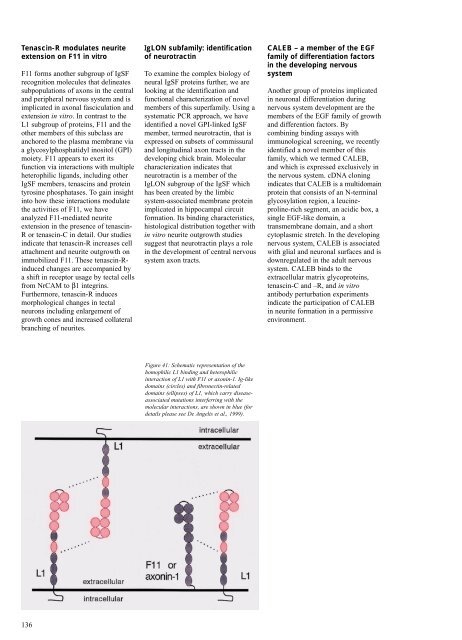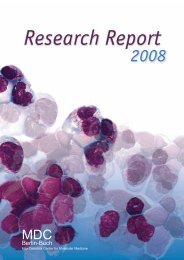Create successful ePaper yourself
Turn your PDF publications into a flip-book with our unique Google optimized e-Paper software.
Tenascin-R modulates neurite<br />
extension on F11 in vitro<br />
F11 forms another subgroup of IgSF<br />
recognition molecules that delineates<br />
subpopulations of axons in the central<br />
and peripheral nervous system and is<br />
implicated in axonal fasciculation and<br />
extension in vitro. In contrast to the<br />
L1 subgroup of proteins, F11 and the<br />
other members of this subclass are<br />
anchored to the plasma membrane via<br />
a glycosylphosphatidyl inositol (GPI)<br />
moiety. F11 appears to exert its<br />
function via interactions with multiple<br />
heterophilic ligands, including other<br />
IgSF members, tenascins and protein<br />
tyrosine phosphatases. To gain insight<br />
into how these interactions modulate<br />
the activities of F11, we have<br />
analyzed F11-mediated neurite<br />
extension in the presence of tenascin-<br />
R or tenascin-C in detail. Our studies<br />
indicate that tenascin-R increases cell<br />
attachment and neurite outgrowth on<br />
immobilized F11. These tenascin-Rinduced<br />
changes are accompanied by<br />
a shift in receptor usage by tectal cells<br />
from NrCAM to β1 integrins.<br />
Furthermore, tenascin-R induces<br />
morphological changes in tectal<br />
neurons including enlargement of<br />
growth cones and increased collateral<br />
branching of neurites.<br />
136<br />
IgLON subfamily: identification<br />
of neurotractin<br />
To examine the complex biology of<br />
neural IgSF proteins further, we are<br />
looking at the identification and<br />
functional characterization of novel<br />
members of this superfamily. Using a<br />
systematic PCR approach, we have<br />
identified a novel GPI-linked IgSF<br />
member, termed neurotractin, that is<br />
expressed on subsets of commissural<br />
and longitudinal axon tracts in the<br />
developing chick brain. Molecular<br />
characterization indicates that<br />
neurotractin is a member of the<br />
IgLON subgroup of the IgSF which<br />
has been created by the limbic<br />
system-associated membrane protein<br />
implicated in hippocampal circuit<br />
formation. Its binding characteristics,<br />
histological distribution together with<br />
in vitro neurite outgrowth studies<br />
suggest that neurotractin plays a role<br />
in the development of central nervous<br />
system axon tracts.<br />
Figure 41: Schematic representation of the<br />
homophilic L1 binding and heterophilic<br />
interaction of L1 with F11 or axonin-1. Ig-like<br />
domains (circles) and fibronectin-related<br />
domains (ellipses) of L1, which carry diseaseassociated<br />
mutations interferring with the<br />
molecular interactions, are shown in blue (for<br />
details please see De Angelis et al., 1999).<br />
CALEB – a member of the EGF<br />
family of differentiation factors<br />
in the developing nervous<br />
system<br />
Another group of proteins implicated<br />
in neuronal differentiation during<br />
nervous system development are the<br />
members of the EGF family of growth<br />
and differention factors. By<br />
combining binding assays with<br />
immunological screening, we recently<br />
identified a novel member of this<br />
family, which we termed CALEB,<br />
and which is expressed exclusively in<br />
the nervous system. cDNA cloning<br />
indicates that CALEB is a multidomain<br />
protein that consists of an N-terminal<br />
glycosylation region, a leucineproline-rich<br />
segment, an acidic box, a<br />
single EGF-like domain, a<br />
transmembrane domain, and a short<br />
cytoplasmic stretch. In the developing<br />
nervous system, CALEB is associated<br />
with glial and neuronal surfaces and is<br />
downregulated in the adult nervous<br />
system. CALEB binds to the<br />
extracellular matrix glycoproteins,<br />
tenascin-C and –R, and in vitro<br />
antibody perturbation experiments<br />
indicate the participation of CALEB<br />
in neurite formation in a permissive<br />
environment.

















